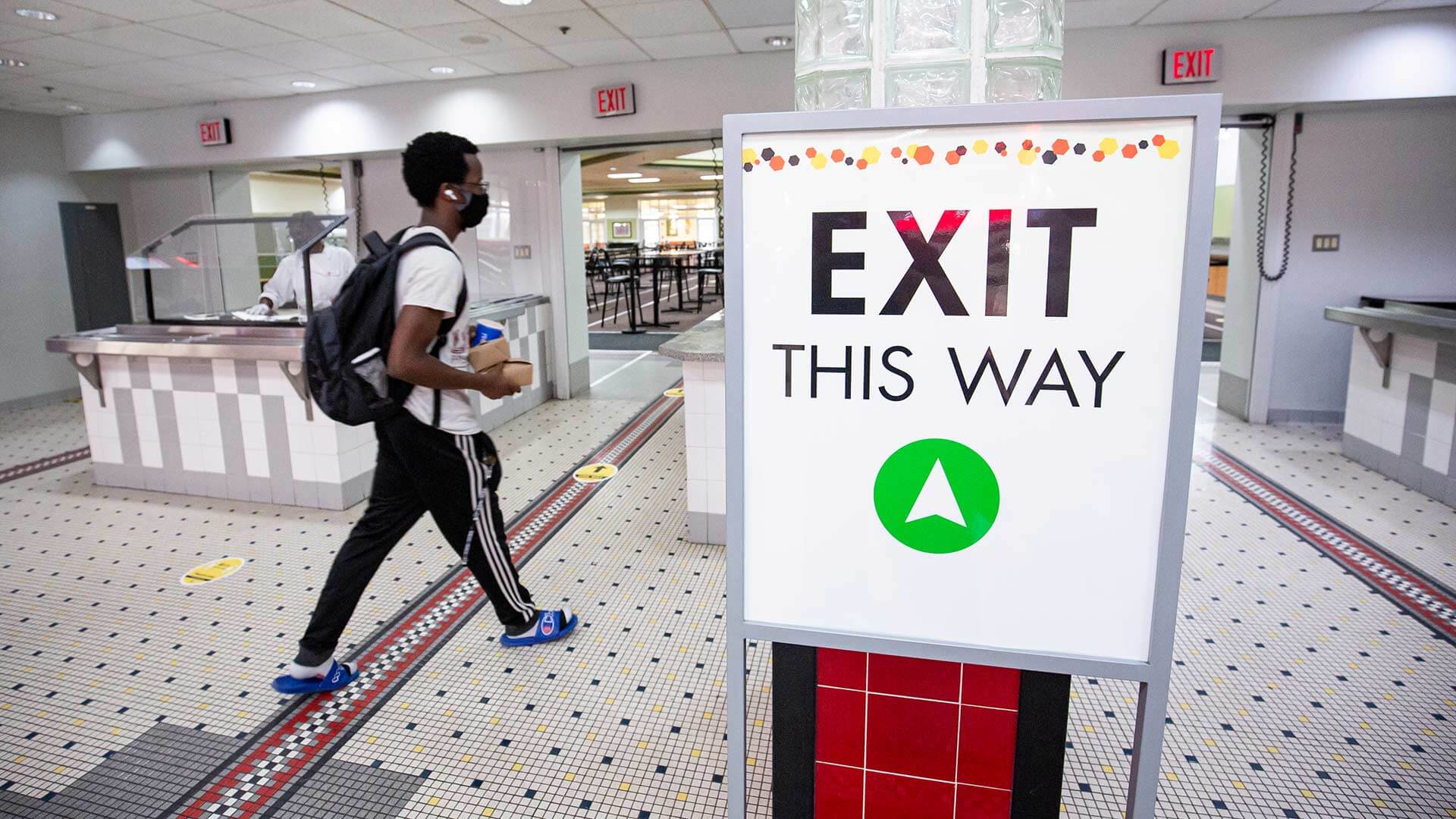- September 01, 2020
- By Aadit Tambe M. Jour ’22
Like everything else this year, eating on campus has changed—a lot—for Fall 2020. From reducing in-person dining to creating different serving methods to new options for people with food allergies, most of what’s changed is driven by safety requirements during the COVID-19 pandemic. What’s stayed the same, however, is the Department of Dining Services’ determination to provide variety, freshness and healthy flavors for the students and others who rely on it every day.
“We’ve worked as hard as we can to create varied menus and give students great Maryland dining experiences,” said Bart Hipple, assistant director of Dining Services.
Here’s some of what’s on the table this semester for students with resident dining plans:
Online classes, carryout meals
Students living on campus have known this since (before) Day One of the semester; others dropping by for a bite might be surprised to discover that for the first two weeks of school, dining halls are serving meals exclusively to go, with six locations to choose from: The Diner, the South Campus Dining Hall, 251 North, and three new “Outpost” locations.
Reservations required (but don’t worry about tipping the maître d’)
Beginning when in-person instruction commences (planned for Sept. 14), The Diner and South Campus Dining Hall will require online reservations for dine-in service, which will include mask requirements except when patrons are seated and eating, and seating six feet apart. Students will make reservations starting the day before and right up until mealtime (although expect certain times to have less availability than others), Hipple said. Walk-in service will continue for breakfast, while 251 North will remain carry-out only.
 Boxed—not boxed in
Boxed—not boxed in
For now, at least, the days of wandering the dining hall with a plate—or multiple plates—and piling up food at random stations have ended. That’s not to say diners won’t have plenty of choices or be able to continue taking advantage of the all-you-care-to-eat policy once dining in resumes; they’ll just need to master the new box system. They’ll have one large entrée box and two smaller side-dish boxes, each of which can only be filled at one station. “The health department doesn’t allow us to pass boxes back and forth,” Hipple said. If you’re ravenous, he said, “students are welcome to ask us to add more to the large box if they would like more food.”
Pressing pause on self-serve
Dining halls will continue to offer a wide variety and emphasize fresh fruits and vegetables—and food will continue to be cooked from scratch using local and UMD-grown ingredients when possible. But students generally will no longer serve themselves, and the professionals in dining halls are laser-focused on COVID-19 safety. Breath guards have been added to some serving stations, and taff will be wearing masks and face shields as appropriate, Hipple said. “They’ll be wearing gloves all the time, and we’ll be changing our utensils frequently.”
 Outposts for dining convenience, variety
Outposts for dining convenience, variety
To provide additional convenient carryout options to students, Hipple said, Dining Services will operate three Outpost locations with streamlined menus that change daily: The Patio at The Diner is an outdoor grill with standbys like burgers, chicken sandwiches and fries. Cambridge, located at the Cambridge Community Center, is serving traditional meals plus more adventurous selections (Samosa Chaat or Andouille Sausage Jambalaya, anyone?) you might not expect in a carryout setting, Hipple said. Sidekick, located in the South Campus Dining Hall building, serves dining hall faves to quickly pick up and go.
Purple Zones defending against allergens
In an effort to provide students more allergen-free food options, Dining Services is introducing Purple Zone stations, on guard against cross-contamination and featuring food free of common nut or other allergens. “Even though we’re operating with stricter restrictions, due to the health crisis, we’re still launching this service for students with allergies,” Hipple said. In addition to a purple station serving a variety of meals, each dining hall will continue to feature a purple fridge stocked with frozen allergen-free food you can microwave on your own.
Commuters on a de-densified campus
Because most students will spend less (or even no) time on campus in Fall 2020, Dining Services reduced the size of Connector Dining Plans, aimed at those living off campus, from 50, 100 or 150 meals, to 25 or 50. But plenty of non-dining hall options for filling up remain: eight cafes, six fast-food locations and three convenience shops. “We looked at how many in-person classes there are scheduled in various buildings on campus,” Hipple said. “Looking at the traffic from last year and what we believe the current in-person class schedule will result in, we kept open as many (locations) as we could.”
Tags
Food